
Space and Plasma Physics
High Altitude Lightning

Space and Plasma Physics
High Altitude Lightning
High Altitude Lightning
The discovery in early nineties of the coupling of lightning energy to the upper atmosphere and the associated phenomena observed in a wide spectral range has been a big surprise. These phenomena are grouped under the name "high altitude lightning" and include red sprites, elves, blue jets, gamma-ray flashes, radio bursts and others. The red sprites and elves, generated due to conventional breakdown caused by static field or electromagnetic pulses (EMP) from lightning, are the best understood among these phenomena.
In the case of red sprites emphasis was on developing a model of its streamer structure. A two step approach was adopted to fulfill this objective. First, the EMP generated during the discharge process in intracloud lightning creates localized patches of conductivity and ionization having a wide range of scales in the lower ionosphere. The patchy structure is a consequence of the fact that intracloud lightning radiates as a fractal antenna with interference patterns corresponding to fractal arrays rather than line radiators [Valdivia5 et al.6, 1997, 1998]. Second, the interaction of the patchy inhomogeneous conductivity structure with the laminar thunderstorm field left in the ionosphere over a dielectric relaxation time was considered. The conducting patches act as catalysts that drive streamers when interacting with the laminar field of the thundercloud [Raizer et al.7, 1998]. The output of the model was the spectrum of the sprite [Milikh8 et al.9, 1996, 1998] (bottom figure) along with the streamer charge and propagation speed.
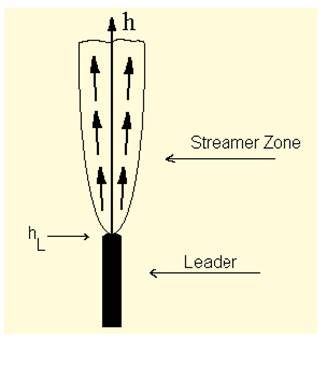
Recently a new model of blue jets was proposed [Raizer et al.10,11, 2006, 2007]. A blue jet consists of the bi-leader, whose top part is seen on photos as a trunk of a tree, and is capped at the top side of the leader by its streamer zone (left figure). Two leaders one of them moving upward while the other moves downward feed each other with the charge and current without any involvement of the cloud charge. Similarly, bi-leaders are formed in the ordinary lightning. It was shown that due to transfer of the high potential of the edge of the thundercloud by the leader, long streamers of blue jets can be sustained by moderate cloud charge. The model estimates the streamer length along with the height at which the streamers can reach the ionosphere. The propagation of a streamer in the exponential
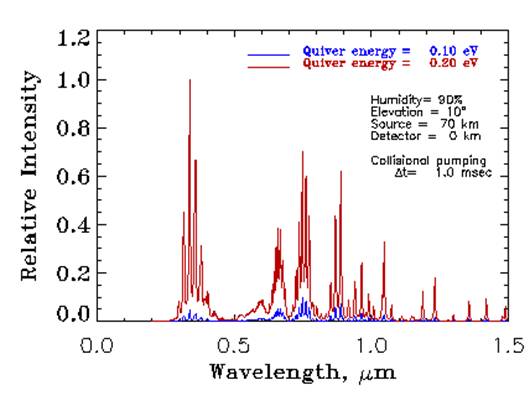
References
1. Runaway Electrons in the Atmosphere in the Presence of Magnetic Field, A.V. Gurevich, J. A. Valdivia, G.M. Milikh and K. Papadopoulos, Radio Sci., 31, 1541-1554, 1996.
2. Model of Gamma Ray Flashes due to Fractal Lightning, G. M. Milikh and J. A. Valdivia, Geophys. Res. Lett., 26, 525-528, 1999.
3. Gamma ray flashes by plasma effects in middle atmosphere, P. K. Kaw, G. M. Milikh, A. S. Sharma, P. N. Guzdar and K. Papadopoulos, Phys. Plasmas, 8(11), 4954-4959, 2001.
4. Gamma ray flashes due to plasma processes in the atmosphere: Role of whistler waves, G. M. Milikh, P.N. Guzdar, and A. S. Sharma, J. Geophys. Res., 110, A02308, doi:10.1029/2004JA010681, 2005.
5. Red Sprites: Lightning as a Fractal Antenna, J. A. Valdivia, G.M. Milikh and K. Papadopoulos, Geophys. Res. Lett., 24, 3169-3172, 1997.
6. Model of Red Sprites Due to Intracloud Fractal Lightning, J. A. Valdivia, G.M. Milikh and K. Papadopoulos, Radio Sci., 33, 1655-1668, 1998.
7. Long Streamers in the Upper Atmosphere Above Thundercloud, Yu. P. Raizer, G. M. Milikh, M. N. Shneider and S. V. Novakovski, J. Phys. D: Applied Phys., 31, 3255-3264, 1998.
8. Spectrum of Red sprites, G. M. Milikh, J. A. Valdivia, and K. Papadopoulos, J. Atmos. & Solar-Terr Phys., 60, 907-915, 1998.
9. Model of Red Sprites Due to Intracloud Fractal Lightning, J. A. Valdivia, G.M. Milikh and K. Papadopoulos, Radio Sci., 33, 1655-1668, 1998.
10. Leader streamer nature of blue jets, Y. P. Raizer, G. M. Milikh, and M. N. Shneider, J. Atmos. & Solar-Terr Phys., 69, 925-938, doi:10.1016/j.jastp.2007.02.007, 2007.
11. On the mechanism of blue jet formation and propagation, Y. P. Raizer, G. M. Milikh, and M. N. Shneider, Geophys. Res. Lett., 33, L23801, doi:10.1029/2006GL027697, 2006.
Model of Blue Jets
Upward-propagating luminous flashes above thunderstorms were discovered two decades ago. They were named blue jets (BJ) due to primarily blue color. It is broadly accepted that BJ are produced by a lightning leader running upward in the nonuniform atmosphere. It is also suggested that formation of a leader is governed by the contraction of the current of a streamer flash into a small radius channel.
Popov [2003] and Bazelyan et al. [2007] presented models based on the hypothesis that the formation of a leader and its further development are governed by the contraction of the current of a streamer flash into a small radius channel and ultimately by its heating of the gas to the temperature characteristic of an arc discharge. A rapid increase in gas pressure near the axis of the plasma channel initiates gas dynamics processes that diminish the gas density thus increasing the reduced electric field E/N (here N is the neutral gas density) which sharply increases the ionization rate. The newly born electrons are in turn heated then pass their energy to the neural gas in electron neutral collisions pumping vibration levels of the gas molecules following by the V-T relaxation, and so on. It gives rise to the thermal-ionization instability which constitutes a universal mechanism which perturbs homogeneous discharges at sufficient pressure and high electric currents in atomic and molecular gases. It results in discharge contraction, and formation of current filaments with higher gas temperature and degree of ionization than in ordinary glow discharges. It is important to note that the instability develops from transverse inhomogeneities while the electric field remains homogeneous along the current direction. Therefore a comprehensive model of the thermal-ionization instability, which is responsible for the current contraction, should be at least two dimensional.
Recently we developed a self-consistent model of current contraction, which is a time dependent 2D model with xisymmetric geometry. We described first the current contraction occurred in pure molecular nitrogen [Shneider et al., 2012], while later on the model was generalized to simulate the current contraction in air [Shneider et al., 2013]. The latter model considers electron attachment to molecular oxygen as well as collisional electron detachment. It also takes into account the effect of convective heat removal that is similar to horizontal wind in the atmosphere.
http://scitation.aip.org/content/aip/journal/pop
Phys. Plasmas 19, 033512 (2012); doi: 10.1063/1.3694913
Nitrogen; p=50 Torr; τ=1 ms; 2D calculations
FIG. Plasma density distributions (in 1012 cm_3) at different times: (a) t=1.2 ms, (b) 1.4 ms, and (c) 1.65 ms.
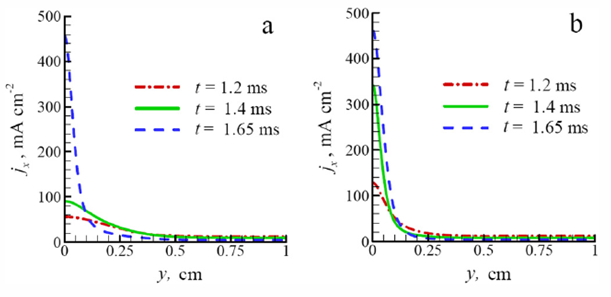
FIG. The evolution of the longitudinal component of the current density jx=jx(y) in two cross-sections of the discharge channel: (a) x=0.51 cm and (b) x=2 cm
Y.P. Raizer, G.M. Milikh,_, M.N. Shneider, Leader–streamers nature of blue jets, Journal of Atmospheric and Solar-Terrestrial Physics 69 (2007) 925–938
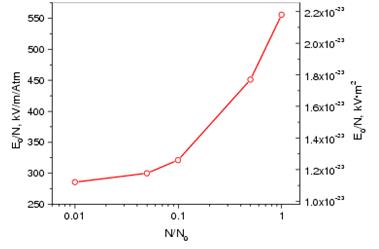
Fig. Values E0/N required for unlimited streamer growth vs. the air density normalized by its normal value
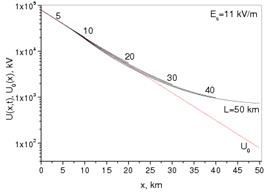
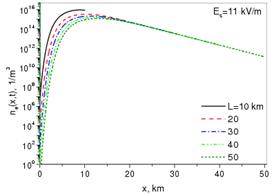
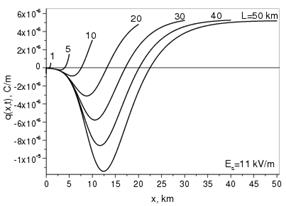
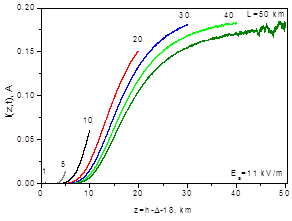
Fig. Results of numerical computations of a long streamer growing in the exponential atmosphere, and in the exponential external field
. The streamer is initiated at x = 0 which corresponds to the height of the leader tip
m-3,
kV/m: (a) The potential distribution along the streamer channel computed at different times when the streamer’s length is 5, 10, 20, 30, 40 or 50 km; (b) respective distribution of the electron density; (c) current distribution; (d) charge per unit channel
The recent paper (Model of Blue Jet Formation and Propagation in the Nonuniform Atmosphere, Milikh, Shneider and Mokrov, submitted to GRL, 2014) presents results of simulations of the current contraction as a function of the air pressure and convective heat removal time. It was shown that transition to the contracted state occurs in hysteresis mode, in which, contracted and diffusive stable states exist simultaneously. The critical current for the phase transition was obtained. Formation and propagation of BJ’s in the atmosphere was studied through a combination of simulations of the critical contraction current and selected direct observations.
The main findings are shown below.

Fig. 1a. Electron density distributions at different times.
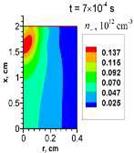
Fig. 1b. Negative ion density distribution at different times.
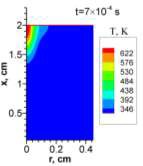
Fig. 1c. Gas temperature distribution at different times.
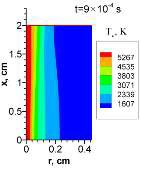
Fig. 1d. Vibrational gas temperature at different times.
Fig. 2. The "current-voltage characteristic" of the glow discharge in air flow at the different pressures. The critical current Icr is shown by the bold trace. If I< Icr the discharge is uniform, if I> Icr the contracted channel is formed.